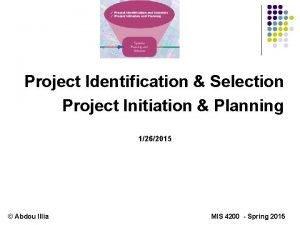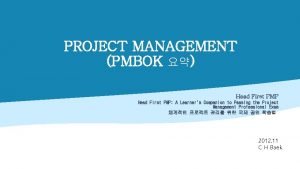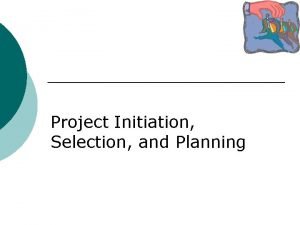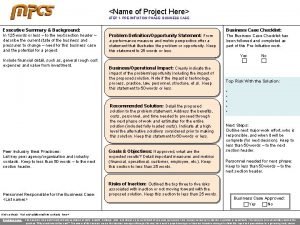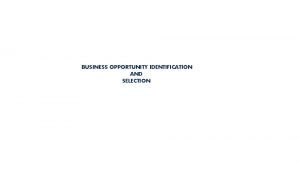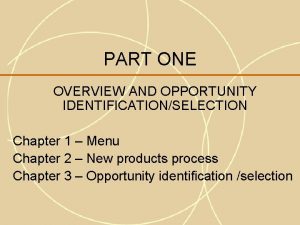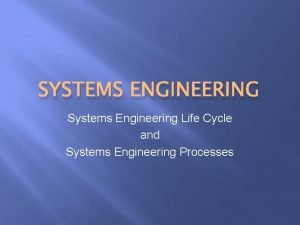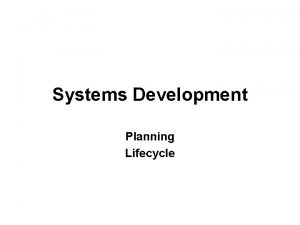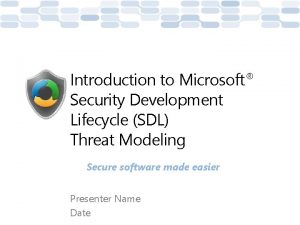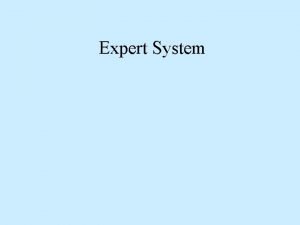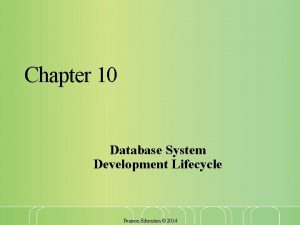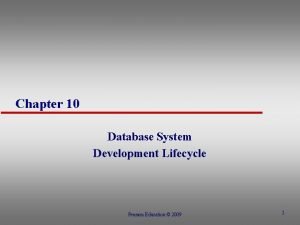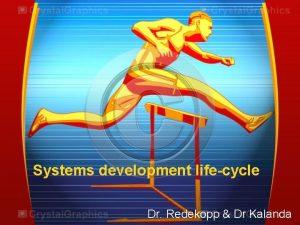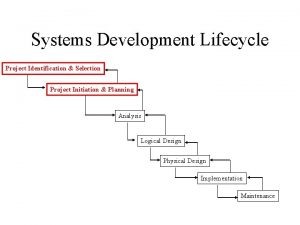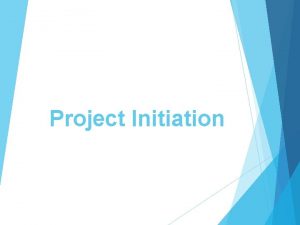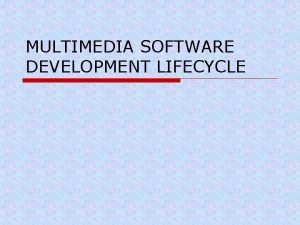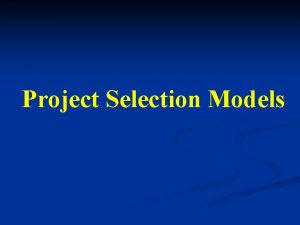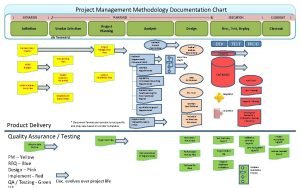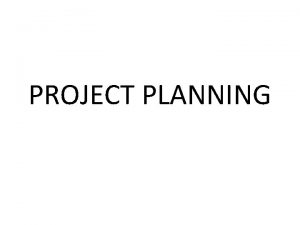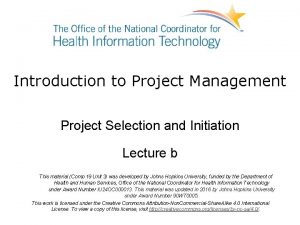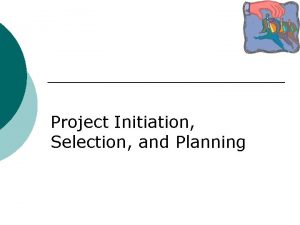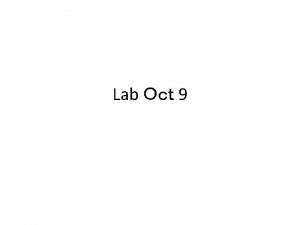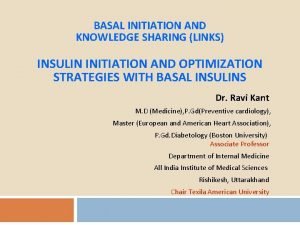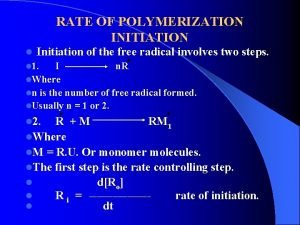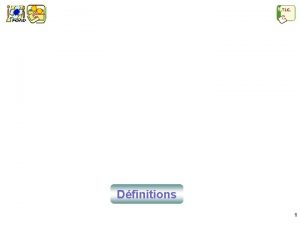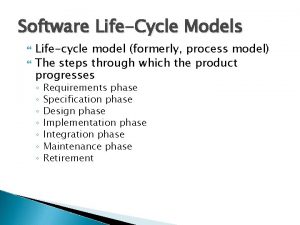Systems Development Lifecycle Project Identification Selection Project Initiation





























- Slides: 29

Systems Development Lifecycle Project Identification & Selection Project Initiation & Planning Analysis Logical Design Physical Design Implementation Maintenance

System Implementation • • • Coding and Integration Testing Installation Documentation Training Support

Coding and Integration • Start with the design products – data flow diagrams, structure charts, logic models, interface and database designs • Get the components – write from scratch – buy packaged – generate • Integrate the components – parameterize and tailor the components – write wrappers and glueware

System Integration Glueware Tailoring Wrapper

Testing Terms • Coverage – ideally, testing will exercise the system in all possible ways – not possible, so we use different criteria to judge how well our testing strategy “covers” the system • Test case – consists of data, procedure, and expected result – represents just one situation under which the system (or some part of it) might run

Test Planning • A test plan includes: – test objectives – schedule and logistics – test strategies – test cases • procedure • data • expected result – procedures for handling problems

Testing Phases In development/ maintenance organization In user organization • Unit testing - does this piece work by itself? • Integration testing - do these two pieces work together? • System testing - do all the pieces work together? • Alpha acceptance testing - try it out with in-house “users” • Installation testing - can users install it and does it work in their environment? • Beta acceptance testing - try it out with real users

Testing Techniques • Structural testing techniques – “white box” testing – based on statements in the code – coverage criteria related to physical parts of the system – tests how a program/system does something • Functional testing techniques – “black box” testing – based on input and output – coverage criteria based on behavior aspects – tests the behavior of a system or program

System Testing Techniques stress testing - test larger-than-normal capacity in terms of transactions, data, users, speed, etc. execution testing - test performance in terms of speed, precision, etc. recovery testing - test how the system recovers from a disaster, how it handles corrupted data, etc. operations testing - test how the system fits in with existing operations and procedures in the user organization compliance testing - test adherence to standards security testing - test security requirements

System Testing Techniques (cont. ) requirements testing - fundamental form of testing makes sure the system does what it’s required to do regression testing - make sure unchanged functionality remains unchanged error-handling testing - test required error-handling functions (usually user error) manual-support testing - test that the system can be used properly - includes user documentation historical test data - tests until the number of defects found approaches the average number of defects in the products produced under similar circumstances

Unit Testing Techniques input domain testing - pick test cases representative of the range of allowable input, including high, low, and average values equivalence partitioning - partition the range of allowable input so that the program is expected to behave similarly for all inputs in a given partition, then pick a test case from each partition boundary value - choose test cases with input values at the boundary (both inside and outside) of the allowable range

Unit Testing Techniques (cont. ) statement testing - ensure the set of test cases exercises every statement at least once branch testing - each branch of an if/then statement is exercised path testing - every path is exercised (impossible in practice) fault seeding - put a certain number of known faults into the code, then test until they are all found

Manual Testing Techniques • Attempt to evaluate a program without executing it • Techniques: – inspections and reviews – walkthroughs and desk checking – mathematical correctness proofs – safety analysis – program measurements – data flow and control flow analysis

Installing the System • Installation process – must be analyzed and designed, too – needs to be tested – needs to be scheduled and managed – need to have a conversion plan • Consider business cycle • Organizational change process

Conversion • Refers to the process of switching from the previous system to the new one • Conversion strategies – direct – parallel – single location – phased • Have to consider conversion of data, hardware, documentation, work methods, physical spaces, business forms, etc.

Types of User Documentation • • • User’s manuals Operator’s manuals Conversion manuals Tutorials Automated Demos Programmer’s Guide Failure Message Reference Guide On-line Help Quick Reference Guides

Documentation in the SDLC • Often left to the most junior members of the team • Or the most incompetent (can do less damage documenting rather than coding) • Devote 5% effort at the last minute • Result: inadequate documentation • Exception when system success depends on satisfaction of general population users

How It Should Happen • Should be managed properly, staffed appropriately, monitored according to schedule • Get started early - before implementation • Use professionals • Thorough review of all documentation • Provide mechanisms for feedback from users • Revise regularly

Documentation Evaluation • • • informal reviews by a variety of reviewers features checklists automated metrics information walkthroughs with users controlled experiments with users field trials with users

Documentation Audiences • Users, operators, programmers, customers, maintainers • Level of technical expertise and experience • What they want to know – “I want to buy it” – “I want to learn it” – “I want to use it” – “I want to fix it” • How much time they have to spend

Training and Support • Often overlooked • Can’t leave it entirely to documentation • Training - upfront instruction, usually intensive • Support - long-term assistance, often for occasional users • On-line training and support more and more expected

Success Factors • • • Management support of new system User involvement during development Commitment to the project from all parties Organizational commitment to change Quality of project definition and planning User expectations

Evolving the System • In an ideal world: The system, once installed, is continuously monitored to determine areas for improvement, to immediately correct problems, and to quickly adapt to changing circumstances. • In reality: The system, once installed, is largely ignored unless it has a catastrophic failure or someone complains loudly enough, in which case it is modified as quickly as possible with the minimum amount of effort.

Maintenance vs. Evolution • Maintenance - individual changes that must be made to a system after installation • Evolution - the long-term change in structure and quality that occurs in a system due to the overall effect of maintenance changes • Evolution results in system deterioration unless it is managed • Managing evolution requires managing maintenance

Systems must be changed because. . . • A defect had to be corrected • The user changed their mind • The user thought of something new (that they’re willing to pay for) • The environment changes • Changes can be made to make future changes easier

“E nh a nce m ent s” Categories of Maintenance Changes • Corrective - fixing bugs • Adaptive - no change to functionality, but now works under new conditions • Perfective - adds something new; makes the system “better” • Preventive - enhances internal structure of system without affecting external behavior

Maintenance Terms • Configuration Control Board (CCB) - organizational unit that makes decisions about what proposed maintenance changes will actually be made • Releases - planned collections of maintenance changes that are applied to a system before it is delivered to customers • Patches - emergency fixes to a system that are delivered to customers between scheduled releases • Configuration management - the process of keeping track of different versions of a system that have been supplied to different customers and that must be maintained separately

Maintenance Terms (cont. ) • Ripple effect - the (usually unintended) effects that a change in one part of a system has on other parts of the system • Impact analysis - analysis of a planned modification to a system in an effort to determine all of the components of the system that will be affected by the modification, including ripple effects • System decay - a degradation of system structure and quality over time due to poorly planned and executed changes • Program comprehension - the human process of understanding a piece of software code • Porting - a type of adaptive maintenance in which a system is translated from one operating system, language, or platform to another

Why is Maintenance Hard? • System maintainers have limited sources of information about the system • Systems are complex and interdependent • Systems are not developed for maintainers • Maintenance is not very glamorous • Maintenance is not very well respected
 Project identification and selection
Project identification and selection Potential development projects can be identified by:
Potential development projects can be identified by: Knapp's relationship escalation model
Knapp's relationship escalation model Project initiation document
Project initiation document Importance of project initiation
Importance of project initiation Tahap inisiasi proyek
Tahap inisiasi proyek Pre initiation phase project management
Pre initiation phase project management Presumptive identification vs positive identification
Presumptive identification vs positive identification Opportunity identification and selection
Opportunity identification and selection Opportunity identification and selection
Opportunity identification and selection Opportunity identification and selection
Opportunity identification and selection Systems engineering life cycle
Systems engineering life cycle Planning phase of sdlc
Planning phase of sdlc Microsoft security development lifecycle
Microsoft security development lifecycle Life cycle of expert system
Life cycle of expert system Database development life cycle
Database development life cycle Pearson education
Pearson education Dr redekopp
Dr redekopp Balancing selection vs stabilizing selection
Balancing selection vs stabilizing selection Similarities
Similarities K selection r selection
K selection r selection Natural selection vs artificial selection
Natural selection vs artificial selection Artificial selection vs natural selection
Artificial selection vs natural selection Disruptive selection example
Disruptive selection example Logistic model of population growth
Logistic model of population growth Natural selection vs artificial selection
Natural selection vs artificial selection Two way selection and multiway selection in c
Two way selection and multiway selection in c Two way selection and multiway selection in c
Two way selection and multiway selection in c Mass selection
Mass selection Clozapine initiation chart
Clozapine initiation chart
